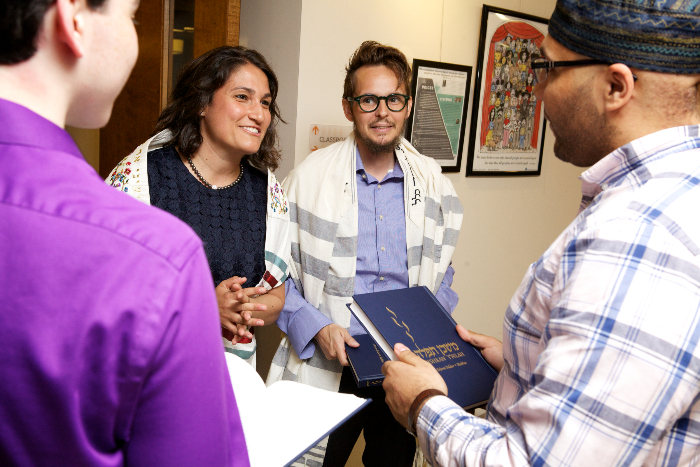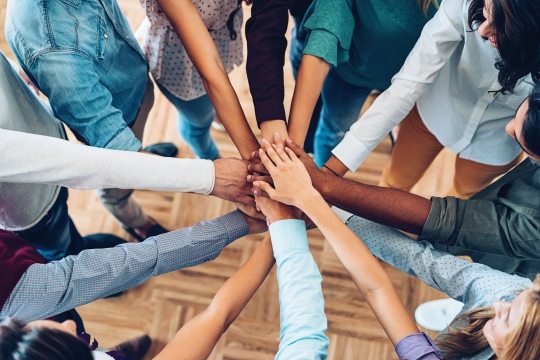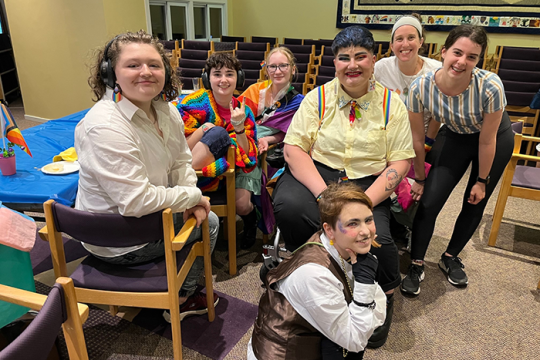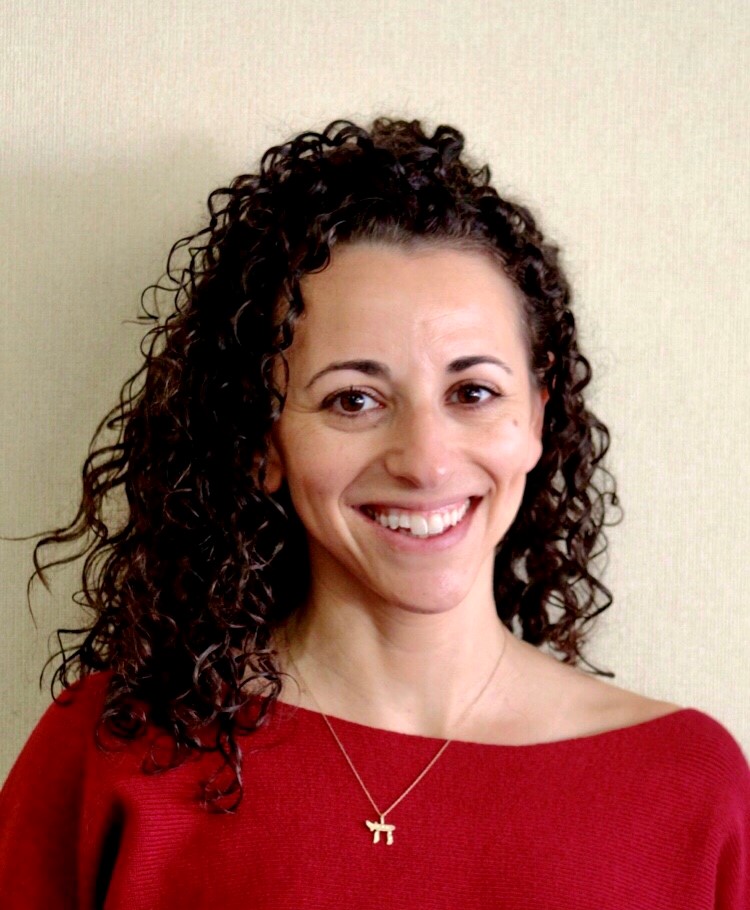
How many times have you visited a congregation’s website or social media page and been greeted by some form of the following phrase?
“Welcome to our community.”
“We have a very warm and welcoming community.”
“We are an open community where everyone is welcome.”
In today’s divided climate, many of us want to demonstrate our commitment to our Jewish communities more than ever. With the best of intentions, we often use the word “welcoming” as a way of describing our communities as we attempt to make new or unfamiliar people feel at home; I, too, have echoed these sentiments many times. However, it’s time to consider a new way of describing and carrying out what, I believe, we actually want to accomplish.
There is an unintended impact of “welcoming” someone into a community: In doing so, the “welcomer” conveys (even if incidental) that it’s their community to welcome someone else into. Jill Housen, an alumni of the URJ’s 2020 Diversity, Equity, & Inclusion (DEI) JewV’Nation Fellowship Cohort, explains:
“When I think of welcoming…I compare it to…welcoming someone into my home, an invitation into my space where I belong because I own my house…”
In other words, when we “welcome,” we often unintentionally convey that it is our place to welcome or decide who is welcome.
“Welcoming” can unintentionally cause those who are on the other end of being welcomed – especially those who live with identities that are less visible in Jewish life – to feel like we’re charitable causes or projects, exceptions to the “norm.” Despite welcomers’ good intentions, it never feels good or empowering to be the subject of this type of benevolence.
“What youth and adults always long for is a sense of belonging somewhere, somehow,” says Tamar Ghidalia, also an alumni from the DEI JewV’Nation Fellowship Cohort, “so in my mind, being welcome in a space is still an effort made by the majority to include the minority.”
“I’ve been welcomed in Jewish spaces before, and the intent is nice, but I’ve also felt included, and I know the difference,” says C.E. Harrison, communications manager for Keshet. “Welcoming me keeps me at arm’s length and prevents me from feeling like I’m a part of a community; it also means people feel entitled to ask me abrupt and personal questions because I’m a Jew of Color. Including me, demonstrating that you truly believe I belong, however, tells me that this community isn’t the same without me in it. It means my identity isn’t something to be ‘othered’ or exotified; it’s an equal part of our beautiful Jewish tapestry.”
I can demonstrate this unintended consequence of a community focused on welcoming rather than belonging when I think back to when I was little and attended a Jewish day school on scholarship. When a teacher told us the class was collecting food for “poor people,” it was clear to me not only that no one from a working-class background had planned the food drive but that my school also assumed “poor people” simply didn’t exist in our Jewish community – an experience that led me to think that the circumstances of my childhood didn’t fit into the expected Jewish experience.
I constantly spent energy hiding parts of my life from my Jewish community: my divorced parents; the fact that my mother and I lived in a one-bedroom apartment where she slept in the living room; my dad using food stamps on the weekend when we grocery shopped; struggles with addiction in my family; and so much more. My Jewish day school always welcomed me, but I never felt like I belonged. As I grew older, still wondering how and if I belonged in the Jewish world, I wondered, too, how and if my queer identity would fit into my Jewish community.
Rather than being an exception to the rule, those of us who are marginalized want to be acknowledged as part of the foundation – as a key ingredient, our lived experiences understood as indispensable and necessary components that make our communities whole. We want to be relied on to help create our communities.
A successful and sustainable community relies on the co-construction of that community by many people, ideally with many different backgrounds, lived experiences, identities, traditions, and leadership styles. As URJ camp counselors Isabella Merritt and Miriam Levy teach:
“The essentialness of true k'hilah k’doshah (holy community) not only embraces the idea that everyone is unique but also recognizes that individuality as essential.”
Our communities are not supposed to belong to only a few leaders, or a few types of leaders from limited lived experience – and yet, so often, the dominant culture that pervades our communities (cisgender, white, heterosexual, male, from “traditional” family structures, single faith households, living without a disability, and other dominant identities) does not reflect the identities of many of us in the Reform Movement.
Reform congregations that have started doing the important work around Racial Equity Diversity & Inclusion (REDI) understand that “doing community” the right way means our communities’ cultures (plural) should reflect our Movement’s actual diversity. They recognize that if the people on our bimahs, in leadership positions, and in the pictures on our walls and on our websites are missing the many faces of Judaism (those who are LGBTQ+, living with a disability, single, BIPOC, intermarried, Jewish-adjacent, working class, etc.), we have created communities of “welcoming” but not communities of belonging.
Until we all commit to learning about the experiences of the underrepresented and missing voices in our communities, we will undoubtedly continue to “other” and marginalize people keeping them “welcomed” but preventing true belonging. If we are ready to create truly inclusive communities, then we must engage in the deep identity work and anti-oppressive strategizing that will enable us to become communities of belonging. This means we must learn about the microaggressions often experienced by Jews of Color and other marginalized identities, and train all members of our community around Racial Equity, Diversity, and Inclusion. We must learn about how the language we use or the forms we ask people to fill out might cause unintentional harm. We must commit to implementing equitable hiring practices and lay leader recruitment strategies that lead to diverse staffs and boards, and we must continue to learn about all the additional ways we can learn and act toward more equitable community-wide practices.
Diversity is not to be simply permitted or welcomed in our communities but should be understood as the only path toward a sustainable Jewish future. Those of us on the margins are not exceptions to a “normal” Jewish community; we are an integral part of the community itself, and we want to know that you know: We all belong here.
To access more resources on how to create a community of belonging, please check out the URJ's Audacious Hospitality Resources.
Have something to say about this post? Join the conversation in The Tent, the communications and collaboration platform for congregational leaders of the Reform Movement. You can also tweet us or tell us how you feel on Facebook.
Related Posts

Setting Your Leaders Up For Success

Safety, Equity, and Accountability is the Path to a Thriving Jewish Community

